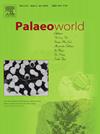Early Eocene Metasequoia and Taxodium (Cupressaceae) from Lingbao, Henan Province and their implication for a perhumid climate in central China
IF 1.7
3区 地球科学
Q2 PALEONTOLOGY
引用次数: 0
Abstract
In this study, fossil leaves of Metasequoia Hu and Cheng, along with leaves and cones of Taxodium Richard, from the lower Eocene of the Xiangcheng Group in Lingbao, Henan Province, central China, were examined. These fossils have been taxonomically assigned to Metasequoia sp. (cf. M. glyptostroboides Hu and Cheng) and Taxodium dubium (Sternberg) Heer. The closest modern relatives are Metasequoia glyptostroboides and Taxodium distichum (Linnaeus) Richard, which typically thrive in humid environments, indicating that similar conditions may have prevailed in early Eocene. Through the Species Distribution Model (SDM) experiment, it was suggested that T. distichum is significantly influenced by precipitation levels, highlighting the importance of moisture in their historical distribution. Moreover, the analysis of the survival environments of native Metasequoia and Taxodium indicates that the annual precipitation in Lingbao during the early Eocene exceeded 1000 mm, which is roughly double the current annual precipitation in the area. This precipitation level is comparable to the present-day subtropical climate zone. During the late Eocene and early Oligocene, the seasonal variation in precipitation was intensified due to the strengthening of the East Asian monsoon, which constrained the seed germination and seedling survival. This may have contributed to the decline in the populations of Metasequoia and Taxodium in East Asia during that period.
河南灵宝早始新世水杉和杉木及其对中国中部过湿润气候的指示意义
本文对河南灵宝相城群下始新世的胡水杉、城水杉和李察水杉的叶片和球果进行了研究。这些化石在分类上归属于水杉属(M. glyptostrobides Hu and Cheng)和dubium (Sternberg) Heer。最近的现代近亲是水杉(Metasequoia glyptostrobides)和Taxodium distichum (Linnaeus) Richard,它们通常在潮湿的环境中茁壮成长,这表明类似的环境可能在始新世早期盛行。通过物种分布模型(SDM)实验表明,旱地柽柳受降水水平的显著影响,突出了水分在其历史分布中的重要性。此外,对原生水杉和红杉生存环境的分析表明,早始新世灵宝地区年降水量超过1000 mm,约为该地区现今年降水量的2倍。这一降水水平与现今的亚热带气候带相当。在始新世晚期和渐新世早期,东亚季风的增强使降水的季节变化加剧,这限制了种子的萌发和幼苗的存活。这可能是造成当时东亚水杉和红杉种群减少的原因。
本文章由计算机程序翻译,如有差异,请以英文原文为准。
求助全文
约1分钟内获得全文
求助全文
来源期刊

Palaeoworld
PALEONTOLOGY-
CiteScore
4.00
自引率
5.90%
发文量
95
期刊介绍:
Palaeoworld is a peer-reviewed quarterly journal dedicated to the study of past life and its environment. We encourage submission of original manuscripts on all aspects of palaeontology and stratigraphy, comparisons of regional and global data in time and space, and results generated by interdisciplinary investigations in related fields. Some issues will be devoted entirely to a special theme whereas others will be composed of contributed articles. Palaeoworld is dedicated to serving a broad spectrum of geoscientists and palaeobiologists as well as serving as a resource for students in fields as diverse as palaeobiology, evolutionary biology, taxonomy and phylogeny, geobiology, historical geology, and palaeoenvironment.
Palaeoworld publishes original articles in the following areas:
•Phylogeny and taxonomic studies of all fossil groups
•Biostratigraphy, chemostratigraphy, chronostratigraphy
•Palaeoecology, palaeoenvironment and global changes throughout Earth history
•Tempo and mode of biological evolution
•Biological events in Earth history (e.g., extinctions, radiations)
•Ecosystem evolution
•Geobiology and molecular palaeobiology
•Palaeontological and stratigraphic methods
•Interdisciplinary studies focusing on fossils and strata
 求助内容:
求助内容: 应助结果提醒方式:
应助结果提醒方式:


